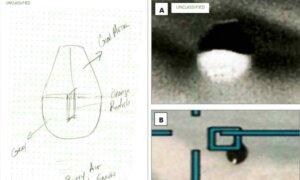5 Key Points to Remember from the Congressional UFO Hearing
Witnesses have reported a pervasive culture of ‘over classification’ within the U.S. government when it comes to anything related to UFOs or UAPs.
A bipartisan group of lawmakers held a congressional hearing on Nov. 13 to discuss unidentified anomalous phenomena (UAP), previously known as UFOs. During the hearing, witnesses highlighted the potential threat to national security posed by possible intrusions into U.S. airspace. They also criticized the Pentagon for keeping many UAP documents hidden from public view.
Key topics discussed included bipartisan congressional interest in UAP, the role of NASA in reporting sightings, the origins of the alleged crafts, and the Pentagon’s practices of classifying and limiting access to UAP documents and materials.
This week’s hearing, unlike a previous one that delved into theories of non-human life, focused more on the Pentagon’s secrecy surrounding UAP sightings and its impact on congressional oversight.
“One of Congress’s essential duties is to oversee the executive branch, especially the military and intelligence community,” Shellenberger emphasized. He believes that withholding such information infringes on congressional authority.
Here are five key points from the congressional UAP hearing on Nov. 13:
1. Ongoing Bipartisan Interest From Congress
Members of the bipartisan UAP caucus, including representatives like Rep. Nancy Mace and Rep. Andy Ogles, were joined by other House members for the hearing, demonstrating continued interest from Congress.
Concerned about the government withholding UAP materials accumulated since the 1940s, Rep. Mace questioned why taxpayer-funded research findings are kept secret, even if they lead to dead ends. She emphasized the importance of transparency, especially when national security could be at risk if UAPs are foreign adversaries’ technology.
Rep. Ogles suggested that certain UAP, including those shown in Pentagon-released videos, may be of foreign origin. He raised the question of whether these objects belong to the US, other nations, or possibly come from outer space.
Any efforts to prevent Congress from accessing this information could be criminal, Ogles added.
Rep. Garcia mentioned the Pentagon’s All-Domain Anomaly Resolution Office, responsible for investigating UAP reports. The office has numerous unexplained sightings showing unusual flight behaviors, many of which have not been identified or classified.
“We need evidence that we are detecting things we don’t understand, and this warrants further investigation,” Garcia remarked.
2. Elizondo’s Testimony
Elizondo, a key witness at the hearing, gained fame for disclosing the Pentagon’s former UFO program to The New York Times in 2017. The article sparked renewed interest and media coverage of UFOs and was accompanied by several videos depicting unidentified aerial phenomena captured by Department of Defense fighter jets.
Elizondo stated during the hearing that some UAP represent “advanced technologies not of our government or any other government,” indicating that both the US and its adversaries possess such technology.
“I believe there is a hidden arms race spanning decades, funded by taxpayer money and kept secret from elected officials and oversight bodies,” Elizondo proclaimed.
Since 2017, Elizondo has maintained that he directed the Pentagon’s 2009 UFO program, officially named the Advanced Aerospace Weapons System Application Program.
“Luis Elizondo had no assigned responsibilities for AATIP while assigned to OUSD(I) [Office of the Under Secretary of Defense for Intelligence],” said Pentagon spokesperson Susan Gough to The Epoch Times.
3. NASA’s Contribution to UAP Reporting
Gold, a member of NASA’s UAP Independent Study Team, proposed that commercial airline pilots need a dedicated database to report potential UAP sightings. He recommended the use of NASA’s Aviation Safety Reporting System (ASRS) for this purpose.
“ASRS has been collecting safety violation reports for 47 years in a confidential, voluntary, and non-punitive manner,” Gold explained. “This system could serve as the basis for collecting UAP data, which could then be analyzed and shared with the public by NASA.”
Gold highlighted NASA’s strong reputation, suggesting that the agency could help rebuild public trust regarding the government’s handling of UAP incidents.
“With minimal resources, NASA could develop an AI or machine learning algorithm to search its archives for unusual phenomena,” Gold proposed.
4. Speculations About Aliens, Drones, or Other Sources
Despite reduced emphasis on theories of non-human intelligence compared to past hearings, the topic was not disregarded.
Rep. Mace questioned Elizondo about alleged UAP retrieval programs within the US government, a subject extensively discussed in previous hearings. Elizondo confirmed that these programs aimed to identify and reverse-engineer alien spacecrafts.
“Considering these aircraft might be piloted by non-human entities, do you believe they could be controlled by some form of mind-body connection?” Luna asked.
Elizondo, focused on the flight characteristics of these objects rather than their origin, suggested that intelligent control was likely due to their ability to anticipate pilot maneuvers.
When asked about the source of UAP by Rep. Garcia, Gallaudet and Elizondo leaned towards higher intelligence from non-human entities, while Shellenberger and Gold remained uncertain.
“Our assumptions about looking for biological intelligence should be cautious, as the source may differ,” Gold cautioned. “The ultimate answer will likely surprise us all.”
Earlier this year, the Pentagon suggested that most unsolved UAP cases could be identified with more data, potentially revealing ordinary objects like drones, satellites, or weather events even within its classified records.
5. The Pentagon’s Involvement in UFOs/UAP
During the hearing, witnesses and lawmakers agreed that the Pentagon has been excessively classifying documents and materials related to UAP sightings, often labeling them as “top secret” and exempt from the Freedom of Information Act (FOIA).
“Why is the federal government over-classifying information? That’s exactly what they’re doing—keeping it secret from the public,” Rep. Biggs expressed.
Elizondo offered two reasons for this practice. Firstly, it may stem from Cold War policies aimed at concealing the US’s knowledge of foreign military technology from adversaries. Secondly, the Pentagon may not be eager to disclose information about challenges such as foreign airspace violations that remain unresolved.
Shellenberger mentioned researcher John Greenewald Jr., the founder of The Black Vault, an online repository containing over 3 million government documents obtained through FOIA requests.
Greenewald revealed that the government often denies the existence of specific UAP records until he files an appeal. In one instance, the Navy classified videos as sensitive and exempt from disclosure.
Referring to the UAP Security Classification Guide used by the Navy, Greenewald stated that any information derived through classified means would receive the highest level of classification, a policy also followed by the Pentagon.
When the Pentagon refused to release footage of US fighter jets encountering UFOs in Alaska in 2023, attributing it to classification, Greenewald noted that all footage involving UAP and MQ-9 Reaper drones is classified to protect sensitive information.
In response to a request for comment, the Department of Defense emphasized its commitment to public interest in UAP and the balance between transparency, accountability, and protecting sensitive information.




